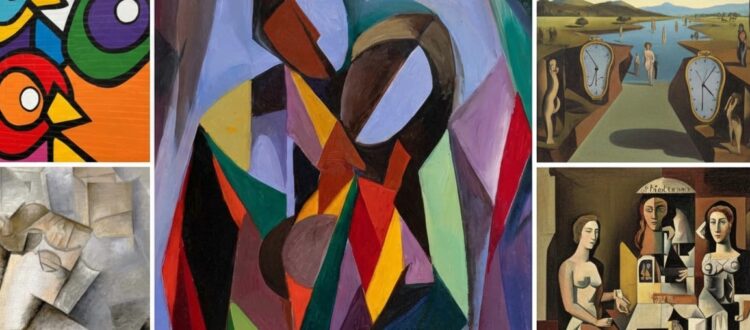Decoding the Canvas: Your Essential Guide to Modern Art
Ever walked into a gallery and found yourself staring at a canvas that seems to defy all logic, a splash of colour or a distorted figure that leaves you both intrigued and a little confused? Welcome to the captivating, often challenging, and always evolving world of Modern Art! Far from being just “pretty pictures,” modern art is a powerful mirror reflecting the societal shifts, psychological depths, and technological advancements of its time. It’s a conversation starter, a rule-breaker, and an endless source of fascination.
But what is modern art exactly, where did it come from, and why do so many people love it? Join us as we unravel the history of modern art, explore the modern art movement, and celebrate the revolutionary spirit that defines this pivotal period in art history.

Also Read: Contemporary Art: Themes & Styles
What is Modern Art?

The simplest answer would be that modern art is the art of modern times. However, what denotes modern times? ‘Modern times’ does not denote the present, but a period in time starting over a century before the present!
In artistic terms, Modern Art refers to all art produced from the 1860s to the 1970s, which comprised many distinct artistic styles.
The modern art movement produced some of the world’s most recognizable and beloved artworks.
Key Characteristics Include:
- Rejection of tradition: Modern artists moved away from classical, academic styles and rigid aesthetic rules, challenging the status quo of what art could be.
- Experimentation: A major focus was on exploring new techniques, materials, and forms of expression.
- Personal expression: The genre emphasized individual vision and emotional experiences over religious or cultural depictions.
- Emphasis on Abstraction: Moving away from literal representation towards symbolic or non-objective forms.
- Influence of societal change: The movement was heavily influenced by rapid societal changes like industrialization & new scientific discoveries.
History of Modern Art

Before the 1860s, art had been available only to the affluent, and the art was mainly based on mythology, religion or self-portraiture.
The term “modern art” is associated with art that challenged the traditions and techniques that came before it.
Artists wanted to respond to modern events and represent the world as they saw it.
Impressionism, Post-Impressionism, Fauvism, Cubism, Surrealism, Dadaism, Abstract Expressionism, and Pop Art are some of the famous modern art movements that have laid a foundational groundwork for much of what we see in contemporary galleries today.
Modern Art Movements

The journey of Modern Art is a thrilling narrative of innovation and rebellion. It didn’t emerge overnight but rather evolved through a series of interconnected movements, each building upon or reacting against its predecessors.
- Impressionism / Post-Impressionism: Captured fleeting light, colour, and everyday moments with loose brushwork that emphasized perception over precision.
- Cubism: Broke subjects into geometric planes to show multiple viewpoints at once, redefining how space and form are seen.
- Abstract Expressionism: Expressed raw emotion and freedom through spontaneous, large-scale, and often non-representational painting.
- Surrealism: Explored the unconscious mind through dreamlike, illogical imagery that blurred reality and imagination.
- Minimalism / Constructivism: Focused on pure form, structure, and simplicity—reducing art to its essential shapes and materials.
- Pop Art: Reacting against the seriousness of Abstract Expressionism, Pop Art embraced consumer culture, advertising, and mass media imagery.
- Mixed Media: Combined diverse materials and unconventional techniques to expand what art could be made from.
Also Read: Impressionism: A Revolutionary Art Movement
Modern Art in India – A Unique Definition

The Modern Art movement in India began in the early 1900s. Unlike their Western counterparts, who championed individual expression and a deeply personal style in their break from tradition, the initial impulse of Indian modernism was fundamentally nationalistic. The early pioneers sought not merely a personal voice, but an authentic, distinctively Indian art form capable of articulating a unique cultural identity in the face of colonial influence.
Key Figures & Movements
- F. Husain, S. H. Raza, F. N. Souza, among others, were part of the influential Progressive Artists’ Group formed in Bombay in 1947 to challenge academic and colonial art traditions.
Greatly influenced by the Swadeshi movement, artists like Rabindranath Tagore and Nandalal Bose rejected the Western concept of naturalism.
The simple Indian folk art of Jamini Roy and the bold post-impressionistic canvases of Amrita Shergill are significant forms of Indian Modern Art.
The Genesis: The Bengal School and the Swadeshi Spirit
The true dawn of Indian Modern Art is often traced back to the Bengal School of Art in the early 20th century. Spearheaded by Abanindranath Tagore, this movement was a direct reaction against the Western academic style promoted by the British Raj. Their goal was to develop a ‘Swadeshi’ aesthetic – art rooted in Indian spirituality, mythology, and cultural narratives, expressed through a uniquely Indian sensibility. This wasn’t merely a stylistic choice; it was a potent act of cultural nationalism.
Themes & Styles
Indian modern art blends:
Indigenous themes — mythology, rural life, Indian iconography.
A modernist vocabulary — abstraction, form, colour, new materials.
For example, Raza’s “Bindu” series mixes Indian spiritual symbolism with modern abstraction.
Why It’s Important
India’s modern art shows how the modern movement was not just European, and how cultural identity, freedom and art-making intersected in the postcolonial era. It is now highly relevant in global art markets, exhibitions and auctions.
Don’t Miss the Upcoming Auction: Giftex Modern & Contemporary Art, November 2025
If you’re looking to dive into modern art with purpose — either as a collector, investor or enthusiast — mark your calendar: the upcoming Modern & Contemporary Art Auction by Giftex this November 2025 offers a prime opportunity.
Why This Auction Matters
It focuses on modern & contemporary art, bridging historical value and present-day relevance.
Auctions are a moment when the hidden value of works becomes visible — you see what the market thinks.
For India and Indian modern art, especially, such events shine a spotlight on artists, trends and investment potential.
How to Approach It
- Research the catalogue early — note artists, provenance, and condition
- Visit previews if possible — seeing art live tells you more than a photo.
- Set a budget and do not get swept up in bidding frenzies.
- Consider the historical value and the broader context
Conclusion: Why Modern Art Still Matters
Modern art matters because it challenges us: it asks us to rethink what art is, what visuals communicate, and how tradition meets innovation. From early modernist paintings in 19th-century Europe to modern Indian canvases and today’s dynamic auctions, the story remains compelling and alive.
For anyone interested in culture, aesthetics, collecting or simply looking at the world differently — engaging with modern art is a rich path. And don’t forget: the November 2025 Giftex auction is a tangible chance to participate in that story






